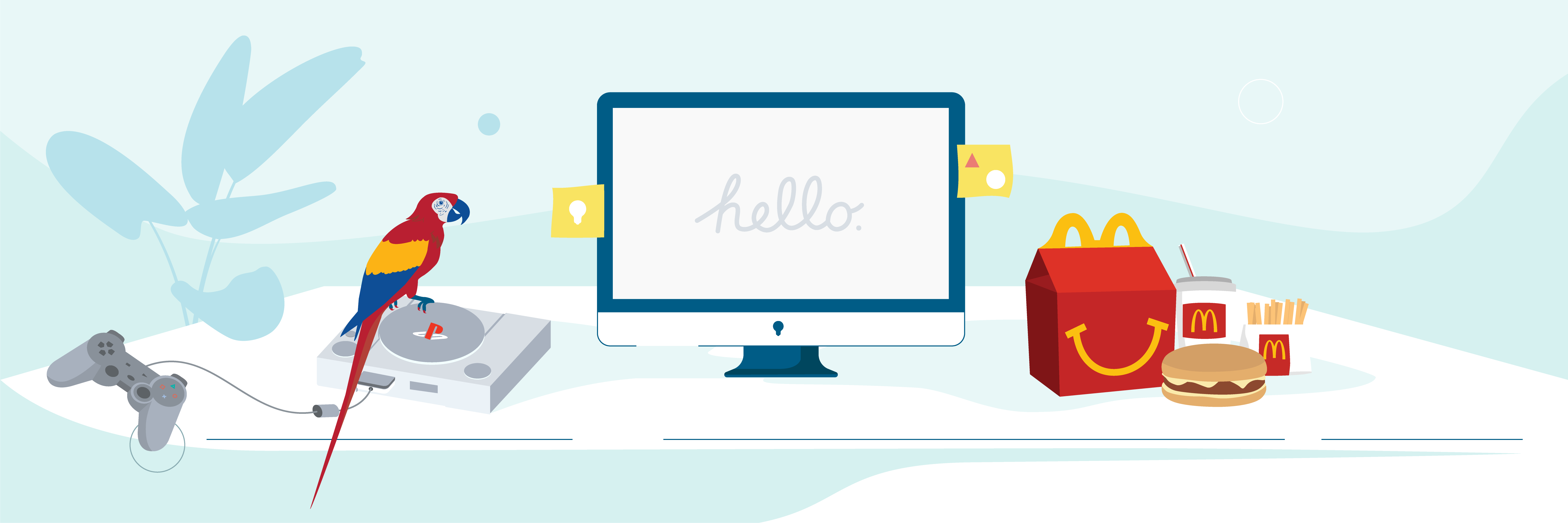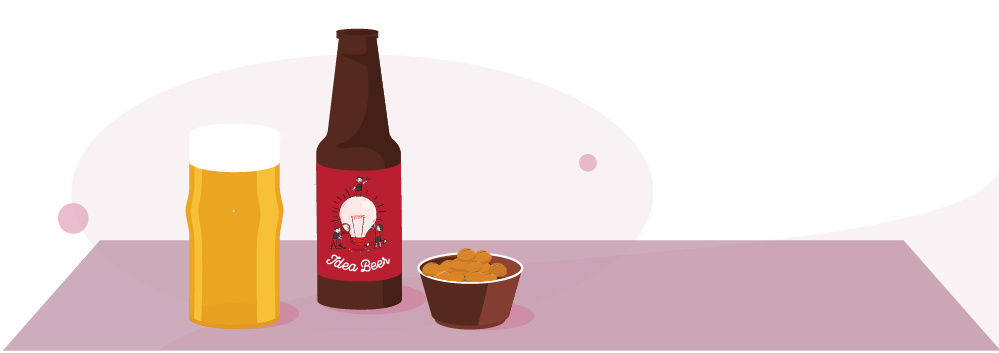+
Get in touch 👋🏽
We would love to hear from you.
Contact us to see how we can help.
We would love to hear from you.
Contact us to see how we can help.

What do the Post-It-Note, Sony PlayStation, and McDonald’s Happy Meal all have in common?
We’ll give you a minute…
Guessed it? These innovations, all of which have seen unimaginable commercial success, were ideas conjured up by employees already working within their respective companies!
Examples of intrapreneurship and employee ideas, such as those listed above, are occurring within businesses of all shapes and sizes where space is created for them to happen, and they are an essential (and surprisingly undervalued) tool within any company’s arsenal.
History is full of examples where new products, innovations and ways to improve the business began with an employee idea.
----- Kieren Banks-Dutton -----
From improving the bottom line to reducing staff turnover, fostering a culture of intrapreneurship and actively engaging employees in innovation within the business will reap incredible results – not just for your business, but for employees, too.
At Sideways 6, we believe that great ideas can come from anywhere. Fantastic things can happen when companies listen to their employees – they just need to set up a process by which they can do it properly.

We’re all very familiar with entrepreneurs, but you may not have heard quite so much about their younger (but by no means less important) counterparts – the intrapreneurs.
So, you may well ask, what is intrapreneurship and why is it good for business?
Definition
Intrapreneurship [noun]
The willingness or ability of people within a large company to take direct responsibility for turning ideas into profitable new products, services, businesses, etc.
Like most younger siblings, intrapreneurship is suddenly stealing the thunder from its orthodox elder – entrepreneurship will continue along its established path, while the intrapreneurs are disrupting the way we think about the world of business.
Taking the analogy a step further (bear with us), the eldest by default assume the leadership role in the sibling bunch, while the youngest have to search for an unoccupied niche in which they can excel, drawing on creativity and resourcefulness in the world that already exists around them.
Intrapreneurship is the younger sibling, spotting the unoccupied niches within their business or organization and innovating around potential solutions and ideas.
Did you know?
The term 'intrapreneurship' was coined by Gifford Pinchot, a sustainable business school founder, over four decades ago and was defined as 'dreamers who do'.
Okay, we may be getting carried away with our metaphors slightly, but you get the point. Put more simply, while entrepreneurs start and lead their own companies, intrapreneurs innovate within existing organizations.
We see intrapreneurship as a synonym of employee ideas and believe in the power of both to dramatically impact businesses from the inside out.
Research we conducted on the State of Employee Ideas showed that 4 in 5 employees (82%) have ideas to change their business, but one in five feels afraid to voice them.
This seems crazy given the proven impact employee ideas can have on a business. Intrapreneurship, after all, isn’t just beneficial to the intrapreneur – businesses stand to benefit, too: Sony's PlayStation revenue topped ~$18m in just the first quarter of 2018...
The bottom-up approach of intrapreneurship, contrary to what most of us are used to, has a number of benefits. These aren't limited to big new revenue streams like the example above, and can include:
Despite organizations spending billions of dollars annually to improve employee engagement to drive innovation, 85% of employees globally remain disengaged, costing about $7 trillion in lost productivity according to Gallup’s State of the Global Workplace Report.
Did you know?
34% of employees feel that their company doesn’t value their ideas.
Engaging employees on ways to improve the business is a mutually beneficial endeavor, and one that any company would seemingly be naive to dismiss.
So we’ve convinced you of the importance of sourcing and listening to employee ideas. Excellent! Except that suddenly seems like a huge challenge, right? Where do you start?
If you’re new to the world of idea and innovation management, fear not – we’ll talk you through the art and science of creating and managing employee ideas campaigns, plus the tips and tricks for ensuring success.
And if you're knee-deep into a campaign and struggling to see the light at the end of the proverbial tunnel, we've also got you covered with our article on the 6 main reasons why your employee ideas campaign isn't working.
Now, the best way to start planning an employee ideas and innovation campaign is with a predefined framework and the right allocation of resources.
Pro-Tip
To maximize engagement, meet people on their terms. Utilize the enterprise social networks to engage employees across any device, location or time zone.
There are two key considerations when planning any ideas campaign: the duration and type of campaign. For how long do you want to be collecting ideas? Are you trying to solve a specific challenge? Questions like these will affect the types of campaign you’ll run.
Campaign duration:
Campaign type:
Pro-Tip
Running multiple campaigns at the same time, such as a targeted time-bound campaign and an always-on open forum, can be the best way to source ideas that will achieve a lasting impact!
You’re probably thinking ‘yes, but you guys can do this because you’re a start-up, not an established business with thousands of employees’. Okay, you’ve got us there, but size (contrary to popular belief) doesn’t really matter. At least when it comes to intrapreneurship...
The established processes and regulations in place in bigger organizations can make change seem like a formidable, unmanageable feat. We get it.
Did you know?
52% of employees we surveyed feel that good ideas fail to be implemented within their company.
If you think about it, though, the bigger your business (and the more employees you therefore have), the greater your chance of finding amazing ideas on the frontlines.
One of the best examples of this is Google's '20% time'. With so many innovative employees within their organization, founders Larry Page and Sergey Brin wanted to find a way to encourage a culture of intrapreneurship and allow individuals to contribute to the evolution of the company, regardless of the department they worked in.
Employees are consequently allowed to spend 20% of their time working on projects of their own choosing that they think can add benefit to Google.
This empowers [employees] to be more creative and innovative. Many of our significant advances have happened in this manner.
Larry Page, Founder @ Google
For top tips on managing an employee ideas campaign in a large business, you can check out some amazing examples in our recent article, 5 things we've learned from 500,000 employee ideas!
Essential for success is understanding how to guarantee stakeholder buy-in for your employee ideas initiative. We’ve broken down the key targets within your company:
Pro-Tip
The trick here is to find and create champions for your campaign – regardless of level, find people who are passionate about ideation and empower them to spread the enthusiasm!
It’s no secret that employee ideas are best sourced when you make it easy for people to contribute them. That often means meeting employees where they are, and where are we more likely to be in the 21st century than online?
Gone are the days of literal suggestion boxes, and in their place employees are expecting to be able to communicate their thoughts and ideas via the same tools of communication they’re using every day.
Organizational hierarchy doesn't matter. A great idea can come from anywhere.
Pete Rummell, Former Chairman @ Disney
In these examples of 5 companies using Workplace by Facebook to generate employee ideas, the integrated approach to idea management (i.e. using the social network already highly adopted within the company to source and manage ideas) makes it easy for employees to submit their ideas and for the organizing committee to manage them.
Walmart, for example, has over 2 million employees scattered around the world. Listening to all of their ideas could be quite the challenge but, as the largest Workplace by Facebook integrated company in the world, they knew how to reach them.
Pro-Tip
Innovation shouldn't be the preserve of specialist teams and departments. Be open to ideas from anywhere and anyone.
Their 90-day employee ideas campaign was crucially supported by senior, listening leaders, and their involvement helped foster a sense of community and employee engagement that hadn’t previously been seen. Three of the top ideas submitted have now been turned into tangible projects!
Another key feature of the success of this employee ideas campaign was the use of existing frameworks and technologies already being utilized within the company.
Continuing this theme, household name British Airways utilized Microsoft Yammer, the enterprise social network already widely used throughout the company, to source ideas around reducing emissions and fuel costs.
The biggest idea of the campaign, however, was to descale the toilet pipes in order to make them lighter. The saving? $800k a year.
BA’s campaign is now estimated to have generated savings worth more than the fuel cost of 550 flights from London to New York!
For more stories from the likes of Severn Trent and British Gas, take a look at these companies using Microsoft Yammer to drive employee ideas.
As employee ideas are our business, we’re often asked whether incentivizing the process makes it more successful.
Generally, we find that the rewards from seeing your ideas listened to and implemented within a business often serve to drive the success of a campaign alone, all while improving employee engagement scores.
Our product marketing expert, Buki, talks through more of the pros and cons associated with incentivizing employee ideas in this video:
It really comes down to intrinsic vs. extrinsic motivation. Why will employees contribute their ideas? While extrinsic motivation comes from some outside source, e.g. an order or promise of a reward (think gift vouchers and gold stars), intrinsic motivation is reliant on the person themselves to want to do it.
The latter are generally the real intrapreneurs – those who innovate for the love of it, for what they will learn, and for the sense of accomplishment they feel at the end. This is where real success is generally derived from, and creating a culture in which these intrapreneurs can flourish is a key step in the road to success!
Pro-Tip
In our experience, recognition works a lot better than incentives do!
Just in case we haven’t convinced you yet, we’ve collated more examples of successful intrapreneurship where some pretty big companies (including the likes of Ford, Amazon, and Starbucks) are fostering an environment of innovation and incubating employee ideas to make some radical, hugely beneficial changes.
One of our favorite examples at Sideways 6, as we already mentioned, is the story of the Happy Meal. One of childhood's biggest icons, the McDonald’s Happy Meal box began as a simple gimmick (no wonder our marketing team loves this story so much!).
Dear McDonald’s cashier, don’t give me that look. There’s no age limit on a happy meal. And don’t forget the toy…
----- Anon -----
In 1977, Dick Brams, Regional Manager of McDonald’s in St Louis, wanted to come up with a new culinary concept just for kids. He pitched the box-based idea to senior leaders and, a short while later, the first Happy Meal was sold.
Three million will be sold today alone. You do the maths.

Well, there are a number of unconventional means that can help encourage employees' creativity. Our favourite? Alcohol!
We know this sounds a little controversial, but beer with us! Really capitalizing on this whole ideas thing (it’s our business, after all), we discovered that there’s a scientific reason to drink beer.
When alcohol hits the part of your brain called the cerebral cortex, it frees you from the distractions normally occupying it, making you more creative (no, really!). As your blood-alcohol level reaches about 0.07 (about two drinks’ worth), your brain is able to make deeper connections and come up with better ideas.
With science on our side, we created our very own ‘Idea Beer’, eventually growing the range to now include ‘Inspiration Sauvignon’ and ‘ Pinnovation Noir’.
Science aside, would we even be a start-up if we didn’t have alcohol in the office?
To alcohol! The cause of... and solution to... all of life's problems!
----- Matt Groening -----
Inspirational drinks aren't just limited to alcohol, either.
Alongside the hard stuff, we've also branded our own 'Clever Bean' coffee (see what we did there?) – as a well-documented stimulant, having a coffee before a brain-storming session can help promote creativity and help you focus on the task at hand!
Time to install a beer fridge in the office?
Did you know?
You can email us at beer@sideways6.com for a free six pack to get you started!
There you have it. Everything you could have wished to know about employee ideas. Probably more, actually (sorry).
Hopefully you're inspired and knowledgeable enough to go forth and conquer the world of employee ideas and intrapreneurship, but if you have any comments, questions, dad jokes, or anything else you want to share, drop us a line at hello@sideways6.com – we'd love to hear from you!
Ideas from Anywhere™
Sideways 6 exists to help bring good ideas to life every day, everywhere from everyone.
»